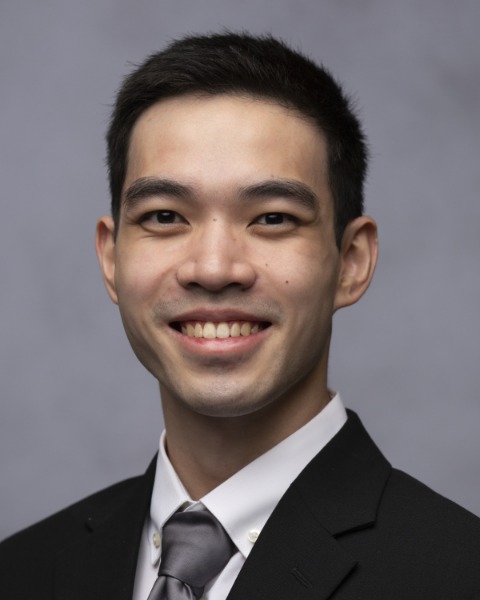Tuesday Poster Session
Category: Interventional Endoscopy
P4538 - Reverse Endoscopic Ultrasound-Guided Neo-Gastrojejunostomy
Tuesday, October 29, 2024
10:30 AM - 4:00 PM ET
Location: Exhibit Hall E

Has Audio

Jenson Phung, MD
University of Minnesota
Minneapolis, MN
Presenting Author(s)
Jenson Phung, MD1, Nabeel Azeem, MD2
1University of Minnesota, Minneapolis, MN; 2University of Minnesota Medical Center, Minneapolis, MN
Introduction: Gastrojejunostomy (GJ) has historically been a surgical procedure used to treat various causes of gastric outlet obstruction (GOO) but comes with high morbidity and mortality risk. Endoscopic ultrasound (EUS) guided GJ has emerged as an alternative to surgery, with initial data showing high clinical and technical success rates.
Case Description/Methods: A 71-year-old female with a prior gastrointestinal stromal tumor treated with a total gastrectomy with a colonic interposition graft was evaluated for post-prandial regurgitation. Upper GI series showed delay in emptying across the interposition graft (neo-stomach) into the proximal jejunum.
On endoscopy, the colojejunal anastomosis appeared to have a benign stenosis. A lumen apposing metal stent (LAMS) and a coaxially placed fully-covered esophageal stent were inserted across the area of stenosis. After 3 weeks, the patient’s symptoms recurred, and imaging showed distal migration of her stents.
The migrated stents were retrieved endoscopically. It then became clear that the obstruction at the colojejunal anastomosis was due to extrinsic compression from her diaphragm from a hiatal hernia. Thus, the decision was made to perform an EUS-guided neo-GJ to allow the neo-stomach to empty into the jejunum further downstream. The Roux limb was distended, and a cautery-assisted LAMS was advanced across the neo-stomach in typical fashion. However, there was misdeployment of the distal flange into the peritoneum. The LAMS was removed and the perforation closed with an over-the-scope clip. The neo-GJ anastomosis was attempted again in reverse fashion. The neo-stomach was distended, and a cautery-assisted LAMS was advanced transjejunally into the neo-stomach. An oral contrast study the next day confirmed stent patency and no extravasation. The patient had no recurrence of symptoms at 6-week follow-up.
Discussion: EUS-guided GJ may provide utility for clinical scenarios that resemble GOO, such as in this patient with extrinsic obstruction of a neo-gastrojejunal anastomosis from the diaphragm. Misdeployment of the distal flange of a LAMS into the peritoneum is the most common type of stent-related complication in this type of procedure. A reverse approach allows the use of a less mobile target, the colonic interposition graft, compared to the small bowel, to decrease the chances of the target being displaced in the process. Further follow-up is needed in our case to better evaluate for long-term effectiveness.

Disclosures:
Jenson Phung, MD1, Nabeel Azeem, MD2. P4538 - Reverse Endoscopic Ultrasound-Guided Neo-Gastrojejunostomy, ACG 2024 Annual Scientific Meeting Abstracts. Philadelphia, PA: American College of Gastroenterology.
1University of Minnesota, Minneapolis, MN; 2University of Minnesota Medical Center, Minneapolis, MN
Introduction: Gastrojejunostomy (GJ) has historically been a surgical procedure used to treat various causes of gastric outlet obstruction (GOO) but comes with high morbidity and mortality risk. Endoscopic ultrasound (EUS) guided GJ has emerged as an alternative to surgery, with initial data showing high clinical and technical success rates.
Case Description/Methods: A 71-year-old female with a prior gastrointestinal stromal tumor treated with a total gastrectomy with a colonic interposition graft was evaluated for post-prandial regurgitation. Upper GI series showed delay in emptying across the interposition graft (neo-stomach) into the proximal jejunum.
On endoscopy, the colojejunal anastomosis appeared to have a benign stenosis. A lumen apposing metal stent (LAMS) and a coaxially placed fully-covered esophageal stent were inserted across the area of stenosis. After 3 weeks, the patient’s symptoms recurred, and imaging showed distal migration of her stents.
The migrated stents were retrieved endoscopically. It then became clear that the obstruction at the colojejunal anastomosis was due to extrinsic compression from her diaphragm from a hiatal hernia. Thus, the decision was made to perform an EUS-guided neo-GJ to allow the neo-stomach to empty into the jejunum further downstream. The Roux limb was distended, and a cautery-assisted LAMS was advanced across the neo-stomach in typical fashion. However, there was misdeployment of the distal flange into the peritoneum. The LAMS was removed and the perforation closed with an over-the-scope clip. The neo-GJ anastomosis was attempted again in reverse fashion. The neo-stomach was distended, and a cautery-assisted LAMS was advanced transjejunally into the neo-stomach. An oral contrast study the next day confirmed stent patency and no extravasation. The patient had no recurrence of symptoms at 6-week follow-up.
Discussion: EUS-guided GJ may provide utility for clinical scenarios that resemble GOO, such as in this patient with extrinsic obstruction of a neo-gastrojejunal anastomosis from the diaphragm. Misdeployment of the distal flange of a LAMS into the peritoneum is the most common type of stent-related complication in this type of procedure. A reverse approach allows the use of a less mobile target, the colonic interposition graft, compared to the small bowel, to decrease the chances of the target being displaced in the process. Further follow-up is needed in our case to better evaluate for long-term effectiveness.

Figure: Figure 1. (A) Videofluoroscopic swallow study showing a colonic interposition, or neo-stomach, with visible hiatal hernia. (B) Endoscopic view of the anatomic position of the distal end of the newly placed lumen-apposing metal stent in the jejunum. (C) Endoscopic view of the anatomic position of the proximal end of the newly placed lumen-apposing metal stent in the neo-stomach, notably away from the recently placed over-the-scope clip and omental patch. (D) Upper GI series with small bowel follow through showing no extravasation of contrast in the neo-stomach or small bowel and confirming stent patency.
Disclosures:
Jenson Phung indicated no relevant financial relationships.
Nabeel Azeem: Boston Scientific – Consultant.
Jenson Phung, MD1, Nabeel Azeem, MD2. P4538 - Reverse Endoscopic Ultrasound-Guided Neo-Gastrojejunostomy, ACG 2024 Annual Scientific Meeting Abstracts. Philadelphia, PA: American College of Gastroenterology.
